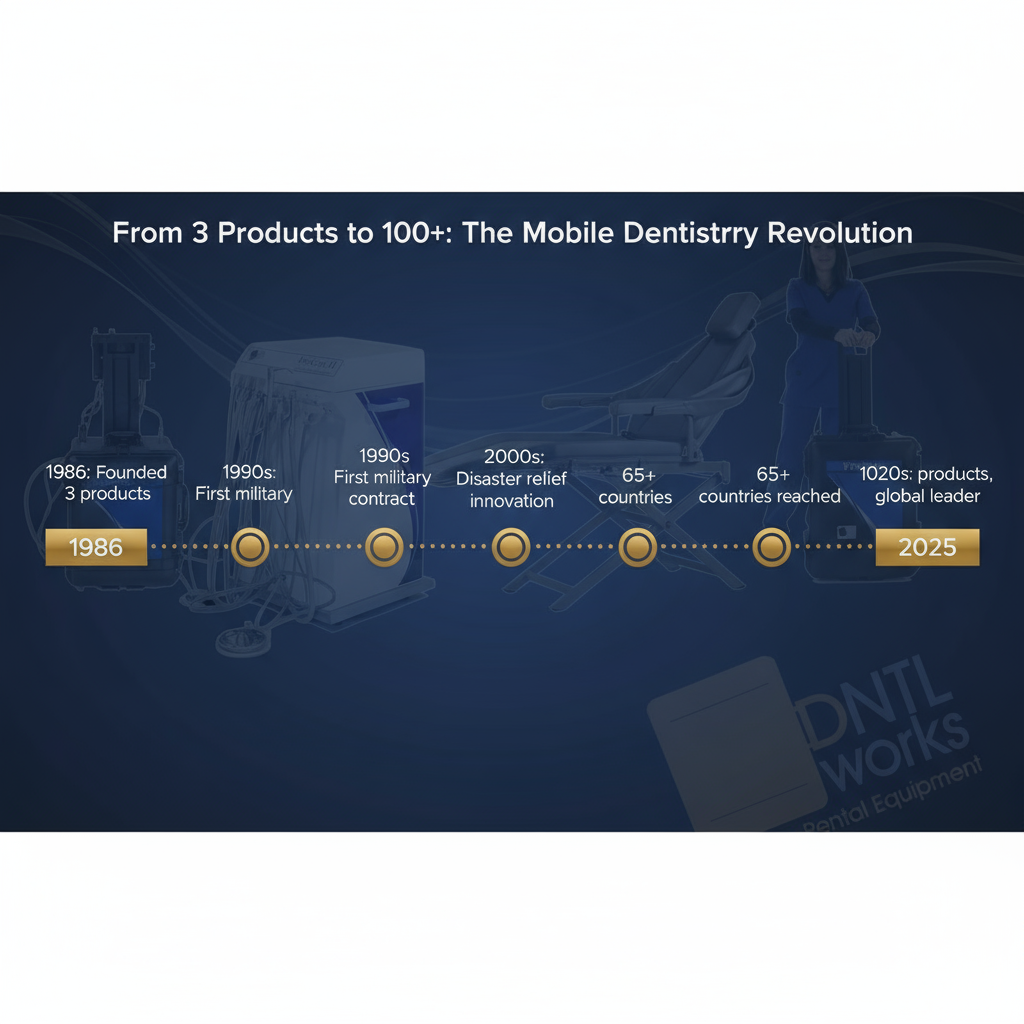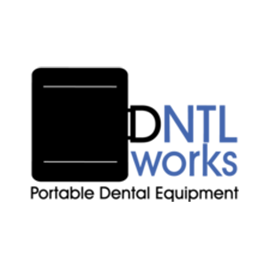
36 Years of Mobile Dental Innovation: How DNTLworks Brought Dentistry to the Unreachable
Share
Picture this: It's 1986. A nursing home resident hasn't seen a dentist in 7 years. Not because they don't want to—they physically can't get to one. Traditional dental chairs require plumbing, electricity, complex installations. The gap in care isn't just inconvenient. It's a health crisis.
That's when DNTLworks asked a different question: What if we brought the dental office to the patient instead?
Fast forward 36 years. That simple question has evolved into 100+ products serving nursing homes, military bases, prisons, disaster zones, and underserved communities across 65+ countries. This is the story of how mobile dentistry went from "impossible" to "industry standard."
The Problem That Started It All:
In the mid-1980s, access to dental care was—and in many places, still is—a privilege of mobility. If you couldn't travel to a traditional dental office, you simply went without care.
The populations most affected:
- Elderly residents in nursing homes and assisted living
- Rural communities hours from the nearest dentist
- Military personnel in field operations
- Prison populations with limited movement
- School children in underserved districts
- Disaster victims in temporary shelters
The equipment didn't exist to serve these populations effectively. Traditional dental units required:
- Complex plumbing installations
- Permanent electrical wiring
- Stationary patient chairs
- Significant square footage
DNTLworks was founded on a radical premise: What if dental equipment could be as mobile as the providers who use it?
The Innovation Timeline: 1986-2025
1986-1990: The Foundation Years
DNTLworks started with a handful of basic portable delivery units. Early models were rudimentary by today's standards, but they proved a critical concept: you could deliver quality dental care without a traditional operatory.
The company focused on three core engineering challenges:
- Self-contained water systems (no plumbing needed)
- Portable suction (effective evacuation without building vacuum lines)
- Reliable power (battery operation for true portability)
Key Innovation: The original ProSolo delivery unit—still a bestseller today—established the template for what portable dentistry could be.
1990-2000: Military & Government Adoption
The U.S. military recognized something DNTLworks had proven: dental care couldn't wait for perfect infrastructure. In field hospitals, disaster relief operations, and deployed units, DNTLworks equipment became mission-critical.
What changed:
- Equipment had to withstand extreme conditions (desert heat, humidity, transport stress)
- Battery life increased to support 20+ patients per charge
- Self-contained systems became more sophisticated
- American manufacturing became a selling point for government contracts
Key Innovation: The ProCart series emerged—fully self-contained mobile dental operatories that could be deployed anywhere.
2000-2010: Global Expansion
Dental access isn't just an American problem. DNTLworks began serving international markets, adapting equipment for diverse environments:
- Remote villages in developing nations
- Mobile health clinics in urban centers
- Refugee camps and humanitarian missions
- Correctional facilities worldwide
The engineering evolution:
- Lighter materials (easier transport)
- Modular designs (customize to specific needs)
- Enhanced fiber optic systems (better visibility in any environment)
- Improved filtration systems (varying water quality conditions)
Milestone: DNTLworks products reached 65+ countries, becoming the global standard for mobile dentistry.
2010-2020: The Mobile Practice Boom
Something interesting happened: Mobile dentistry went from "necessity solution" to "smart business model."
Dentists discovered they could:
- Reach underserved markets with less overhead
- Build practices around nursing home circuits
- Offer premium concierge services
- Respond to community needs flexibly
DNTLworks responded with:
- 100+ products ranging from basic ($3,713 ProPak II) to sophisticated ($12,689 ProCart III)
- Customizable configurations for every budget and use case
- Enhanced ergonomics for providers working in varied environments
- Integration with modern digital X-ray and imaging systems
Key Innovation: The complete "Hygiene Startup Package" made mobile practice entry more accessible than ever.
2020-2025: Pandemic Proof & Future Ready
The COVID-19 pandemic validated everything DNTLworks had built. When traditional offices faced shutdowns and patient hesitancy, mobile providers could:
- Meet patients in safer, isolated environments
- Reduce cross-contamination risks
- Serve high-risk populations without facility transfers
- Maintain continuity of care during crises
Current state:
- Over 100 products in the catalog
- Continuous product upgrades and new development
- Partnerships with dental schools teaching mobile techniques
- Growing recognition that mobile dentistry isn't "alternative"—it's essential
The Engineering Philosophy: Why "Made in USA" Matters
DNTLworks has maintained American manufacturing for 36 years. Here's why that's not just patriotic marketing—it's strategic engineering:
1. Quality Control Every component is traceable. When a ProCart III is deployed to a military base or disaster zone, failure isn't an option. American manufacturing standards ensure consistency.
2. Rapid Iteration
When providers identify improvements, DNTLworks can implement changes quickly. Design, prototype, test, manufacture—all under one roof means faster innovation cycles.
3. Custom Solutions OEM accounts and specialty applications require customization. In-house manufacturing means "we can build that" instead of "we'll check with our supplier."
4. Economic Ecosystem Supporting American jobs, suppliers, and communities has compounding effects on quality and reliability.
The Products That Changed Everything
ProSolo: The Gateway ($5,188)
This is where most mobile practices begin. Six mounting options mean it adapts to nearly any scenario:
- Chair mount (operatory integration)
- Wheeled floor stand (maximum mobility)
- Tripod stand (stability anywhere)
- Surface mount (semi-permanent installation)
- Post mount (custom configurations)
- Swing arm mount (space optimization)
Why it's still a bestseller after decades: It's the "just enough" solution. Not over-engineered. Not under-powered. Exactly what's needed to start serving mobile patients profitably.
ProCart III: The Gold Standard ($12,689)
When military field hospitals and disaster relief organizations specify equipment, this is what they choose.
What makes it different:
- Completely self-contained (water, suction, power)
- 20+ patient capacity per charge
- High-speed handpiece delivery
- Professional-grade suction
- Built for the harshest environments
It's not the cheapest option. It's the "never let you down" option.
ProSeal Series: The Hygiene Specialists
Recognizing that many mobile practices focus on hygiene and prevention, DNTLworks developed dedicated portable hygiene units:
- ProSeal I ($4,497): Entry-level hygiene
- ProSeal II ($8,746): Advanced hygiene with more capacity
Strategic insight: By creating category-specific equipment, DNTLworks helped define mobile hygiene as its own specialty, not just "limited dentistry."
The Applications: Where Mobile Dentistry Thrives
Nursing Homes & Assisted Living
The original use case remains the largest market. With aging populations and increasing facility-based care, mobile dentistry solves a massive access problem.
Economic reality: A nursing home with 100 residents can contract a mobile provider, improving resident health outcomes while the dentist builds a predictable, high-value practice.
School-Based Programs
Pediatric dental care in schools removes transportation barriers for families. Mobile equipment turns a gymnasium or cafeteria into a dental clinic for the day.
Impact: Studies show school-based dental programs dramatically increase access, especially in low-income communities.
Correctional Facilities
Dental care is constitutionally required for incarcerated individuals, but building permanent operatories in every facility isn't practical. Mobile dentistry solves this.
Military & Disaster Relief
When hurricanes hit, when deployments happen, when refugee crises emerge—dental care can't wait for infrastructure. DNTLworks equipment has been in every major disaster response for decades.
The standard: If you see dental care happening in a field hospital or disaster zone, there's a good chance it's DNTLworks equipment.
Government Health Programs
VA hospitals, Indian Health Services, public health departments—these organizations serve populations where access is the primary barrier. Mobile solutions expand reach without massive capital investment.
What's Next: The Future of Mobile Dentistry
After 36 years, DNTLworks isn't slowing down. Current development focuses on:
1. Digital Integration
- Seamless pairing with digital X-ray systems
- Cloud-based patient record access
- Teledentistry capabilities for diagnostics
2. Sustainability
- Longer battery life and more efficient power systems
- Water conservation features
- Recyclable components
3. Ergonomics
- Reducing provider fatigue during mobile practice
- Lighter materials without sacrificing durability
- More intuitive equipment layouts
4. Accessibility
- Equipment designed for providers with different physical abilities
- Patient positioning options for various mobility limitations
- Universal design principles
The Bigger Picture: Why This Matters
Mobile dentistry isn't a trend. It's a fundamental reimagining of care delivery.
Consider the math:
- Traditional office: High overhead, limited geographic reach, patients must travel
- Mobile practice: Lower overhead, unlimited geographic reach, provider travels to patients
The result: Better access, potentially better economics, definitely better outcomes for underserved populations.
DNTLworks didn't just build equipment. They built the infrastructure for a more equitable dental care system.
Conclusion: 36 Years, Same Mission
Since 1986, the question hasn't changed: How do we bring quality dental care to people who can't reach it?
The answer has evolved from a few basic portable units to a comprehensive ecosystem of 100+ products serving 65+ countries. But the mission remains constant.
Every ProSolo that rolls into a nursing home. Every ProCart III that deploys to a disaster zone. Every school child who receives care in their gymnasium instead of missing it entirely.
That's 36 years of mobile dental innovation in action.
Because dentistry shouldn't require a building. It should require a provider, a patient, and the right tools.
Ready to join the mobile revolution? Explore DNTLworks equipment and see why we've been the trusted choice for 36 years.
